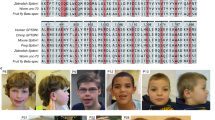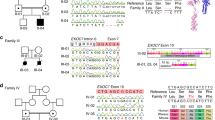Abstract
LIS1 is one of the genes that has a principle role in brain development since hemizygote mutations in LIS1 result in a severe brain malformation known as lissencephaly (‘smooth brain’). LIS1 is a WD repeat protein and is known to be involved in several protein complexes that are likely to play a functional role in brain development. We discuss here the brain developmental phenotype observed in mice heterozygote for an N-terminal truncated LIS1 protein in view of known LIS1 protein interactions.
This is a preview of subscription content, access via your institution
Access options
Subscribe to this journal
Receive 12 print issues and online access
$259.00 per year
only $21.58 per issue
Buy this article
- Purchase on Springer Link
- Instant access to full article PDF
Prices may be subject to local taxes which are calculated during checkout

Similar content being viewed by others
References
Cahana A et al. Proc Natl Acad Sci USA 2001 98: 6429–6434
des Portes V et al. Cell 1998 92: 51–61
Gleeson JG et al. Cell 1998 92: 63–72
Reiner O et al. Nature 1993 364: 717–721
Dobyns WB et al. J Am Med Ass 1993 270: 2838–2842
Lo Nigro CL et al. Hum Mol Genet 1997 6: 157–164
Pilz DT et al. Hum Mol Genet 1998 7: 2029–2037
Fogli A et al. Ann Neurol 1999 45: 154–161
Neer EJ et al. Nature 1994 371: 297–300
Reiner O . Neuron 2000 28: 633–636
Morris NR et al. Trends Cell Biol 1998 8: 467–470
Xiang X et al. Mol Biol Cell 1995 6: 297–310
Morris SM et al. Curr Biol 1998 8: 603–606
Willins DA et al. Genetics 1995 141: 1287–1298
Sapir T et al. EMBO J 1997 16: 6977–6984
Sapir T et al. Eur J Biochem 1999 265: 181–188
Beckwith SM et al. J Cell Biol 1998 143: 1239–1247
Xiang X et al. Proc Natl Acad Sci USA 1994 91: 2100–2104
Xiang X et al. Curr Biol 2000 10: 603–606
Han G et al. Curr Biol 2001 11: 1–20
Liu Z et al. Development 1999 126: 4477–4488
Swan A et al. Nat Cell Biol 1999 1: 444–449
Lei Y, Warrior R . Dev Biol 2000 226: 57–72
Fujiwara T et al. Mol Cell Biol 1999 19: 8016–8027
Sasaki S et al. Neuron 2000 28: 681–696
Faulkner NE et al. Nat Cell Biol 2000 2: 784–791
Smith DS et al. Nat Cell Biol 2000 2: 767–775
Sharp DJ . Nature 2000 407: 41–47
Goldstein LS, Yang Z . Annu Rev Neurosci 2000 23: 39–71
Efimov VP, Morris NR . J Cell Biol 2000 150: 681–688
Minke PF et al. Mol Microbiol 1999 32: 1065–1076
Feng Y et al. Neuron 2000 28: 665–679
Hayashi MA et al. Biochem Biophys Res Commun 2000 269: 7–13
Niethammer M et al. Neuron 2000 28: 697–711
Kitagawa M et al. FEBS Lett 2000 479: 57–62
Kwon YT, Tsai LH . Results Probl Cell Differ 2000 30: 241–253
Chae T et al. Neuron 1997 18: 29–42
Gilmore EC et al. J Neurosci 1998 18: 6370–6377
Kwon YT, Tsai LH . J Comp Neurol 1998 395: 510–522
Ohshima T et al. Proc Natl Acad Sci USA 1996 93: 11173–11178
Caspi M et al. Hum Mol Genet 2000 9: 2205–2213
Horesh D et al. Hum Mol Genet 1999 8: 1599–1610
Francis F et al. Neuron 1999 23: 247–256
Gleeson JG et al. Neuron 1999 23: 257–271
Sapir T et al. Hum Mol Genet 2000 5: 703–712
Hattori M et al. Nature 1994 370: 216–218
Manya H et al. J Biol Chem 1998 273: 18567–18572
Sheffield P et al. Proteins 2000 39: 1–8
Kornecki E, Ehrlich YH . Science 1988 240: 1792–1794
Yue TL, Feuerstein GZ . Crit Rev Neurobiol 1994 8: 11–24
Bazan NG . Prog Brain Res 1998 118: 281–291
McNeil RS et al. Cell Motil Cytoskeleton 1999 43: 99–113
Adachi T et al. Neurosci Lett 1997 235: 133–136
Bix GJ, Clark GD . J Neurosci 1998 18: 307–318
Gould SJ, Valle D . Trends Genet 2000 16: 340–345
Powers JM . J Neuropathol Exp Neurol 1995 54: 710–719
Baes M et al. Nat Genet 1997 17: 49–57
Cahana A, Reiner O . FEBS Lett 1999 451: 99–102
Hirotsune S et al. Nat Genet 1998 19: 333–339
Liu Z et al. Nat Cell Biol 2000 2: 776–783
Fleck MW et al. J Neurosci 2000 20: 2439–2450
Sapir T et al. Eur J Biochem 1999 266: 1011–1020
Ahn C, Morris NR . J Biol Chem 2001 276: 9903–9909
Garcia-Higuera I et al. Biochemistry 1996 35: 13985–13994
Ghosh A, Shatz CJ . Development 1993 117: 1031–1047
Ghosh A et al. Nature 1990 347: 179–181
Katz LC, Shatz CJ . Science 1996 274: 1133–1138
Finney EM, Shatz CJ . J Neurosci 1998 18: 8826–8838
Edwards MA et al. Neuroscience 1990 36: 121–144
Super H et al. Brain Res Brain Res Rev 1998 27: 40–64
Rakic P . Proc Natl Acad Sci USA 1995 92: 11323–11327
Manya H et al. J Biol Chem 1999 274: 31827–31832
Clark GD et al. Neuroreport 1995 6: 2569–2575
Acknowledgements
Supported in Part by Fritz Thyssen Stiftung Foundation, BSF grant No. 97–00014, HFSP grant No. RG283199 9, Volkswagen-Stiftung, the Israeli Science Foundation grant No. 19/00, and Minerva Foundation, to OR, and by DGSYC project PM 98–0056, Foundation Seneca of Murcia: project 00708-CV-99 and CE Contracts QLG2-CT-99–793, QLG3–00–01625 to SM. OR is an Incumbent of Aser Rothstein Career Development Chair in Genetic Diseases.
Author information
Authors and Affiliations
Corresponding author
Rights and permissions
About this article
Cite this article
Reiner, O., Cahana, A., Escamez, T. et al. LIS1—no more no less. Mol Psychiatry 7, 12–16 (2002). https://doi.org/10.1038/sj.mp.4000975
Published:
Issue Date:
DOI: https://doi.org/10.1038/sj.mp.4000975
This article is cited by
-
Properties of the epileptiform activity in the cingulate cortex of a mouse model of LIS1 dysfunction
Brain Structure and Function (2022)
-
Gene expression alterations related to mania and psychosis in peripheral blood of patients with a first episode of psychosis
Translational Psychiatry (2016)
-
Disrupted in Schizophrenia 1 Interactome: evidence for the close connectivity of risk genes and a potential synaptic basis for schizophrenia
Molecular Psychiatry (2007)
-
A frameshift mutation in Disrupted in Schizophrenia 1 in an American family with schizophrenia and schizoaffective disorder
Molecular Psychiatry (2005)



